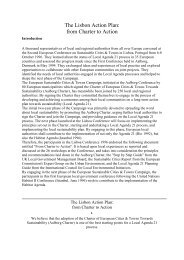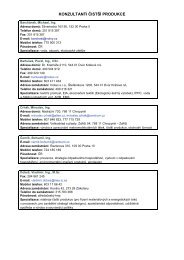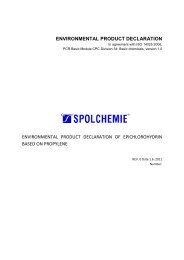Environmental Technologies and Eco-innovation in the Czech ...
Environmental Technologies and Eco-innovation in the Czech ...
Environmental Technologies and Eco-innovation in the Czech ...
You also want an ePaper? Increase the reach of your titles
YUMPU automatically turns print PDFs into web optimized ePapers that Google loves.
The oxidation of ammonia nitrogen to<br />
nitric nitrogen <strong>in</strong> activation is ensured by<br />
nitrification bacteria. However, <strong>the</strong>ir share<br />
<strong>in</strong> activated sludge ranges only from 1 to 3%.<br />
Such low concentrations are given by <strong>the</strong><br />
lower growth rate of nitrification bacteria<br />
compared to o<strong>the</strong>r bacteria. The most widespread<br />
manner of compensat<strong>in</strong>g for <strong>the</strong>ir<br />
low growth speed is <strong>in</strong>creas<strong>in</strong>g <strong>the</strong> sludge<br />
age 13 , which, however, leads to reduc<strong>in</strong>g<br />
<strong>the</strong> bacteria activity <strong>and</strong> to <strong>the</strong> need of<br />
larger activation tanks. An alternative to<br />
<strong>in</strong>crease <strong>the</strong> nitrification bacteria share<br />
<strong>in</strong> <strong>the</strong> activated sludge is <strong>the</strong> <strong>in</strong>clusion of<br />
<strong>in</strong> situ nitrification bioaugmentation,<br />
dur<strong>in</strong>g which nitrification bacteria<br />
cultivation takes place <strong>in</strong> a detached part of<br />
<strong>the</strong> regeneration tank, <strong>in</strong>to which a source<br />
is lead conta<strong>in</strong><strong>in</strong>g substances with nitrogen<br />
present, preferably <strong>the</strong> water from activated<br />
sludge dewater<strong>in</strong>g. The grown nitrification<br />
bacteria are <strong>in</strong>troduced back <strong>in</strong>to <strong>the</strong><br />
system <strong>in</strong> order to <strong>in</strong>crease <strong>the</strong> nitrification<br />
bacteria concentration <strong>in</strong> <strong>the</strong> activation<br />
tank to <strong>in</strong>crease <strong>the</strong> nitrification efficiency.<br />
This method was successfully applied <strong>in</strong><br />
Prague’s Central WWTP <strong>and</strong> <strong>in</strong> <strong>the</strong> Ústí<br />
nad Labem WWTP. By <strong>in</strong>troduc<strong>in</strong>g this<br />
technology, a significant <strong>in</strong>crease <strong>in</strong> <strong>the</strong><br />
efficiency of nitrogen removal was reached.<br />
With <strong>the</strong> correct WWTP design with <strong>in</strong> situ<br />
nitrification bioaugmentation <strong>in</strong> place, <strong>the</strong><br />
required activation tank sizes are reduced<br />
by as much as 40% <strong>and</strong>, at <strong>the</strong> same time,<br />
this br<strong>in</strong>gs an operat<strong>in</strong>g cost sav<strong>in</strong>gs by as<br />
much as 10%.<br />
6.4 | New methods of activated sludge separation 13<br />
One of <strong>the</strong> essential phases of biological waste water treatment is <strong>the</strong> separation of<br />
activated sludge from treated waste water. Bad separation can lead to leakage of <strong>the</strong><br />
activated sludge <strong>in</strong>to <strong>the</strong> discharge, which significantly <strong>in</strong>creases <strong>the</strong> concentrations of<br />
<strong>the</strong> discharge <strong>in</strong>dicators <strong>and</strong> deteriorates <strong>the</strong> overall treatment. In <strong>the</strong> waste treatment<br />
practice, <strong>the</strong> classical f<strong>in</strong>al settl<strong>in</strong>g tanks are be<strong>in</strong>g more <strong>and</strong> more often replaced<br />
with membrane filters 14 that are ei<strong>the</strong>r submerged directly <strong>in</strong>to <strong>the</strong> activation tank<br />
or outside <strong>the</strong> activation tank, or <strong>the</strong>y are located <strong>in</strong> a separate tank. Air is supplied<br />
<strong>in</strong>to <strong>the</strong> system for biodegradation needs <strong>and</strong> for clean<strong>in</strong>g <strong>the</strong> membranes. The driv<strong>in</strong>g<br />
power of <strong>the</strong> treated water discharge is <strong>the</strong> difference of hydrostatic pressures 15 <strong>in</strong><br />
front of <strong>and</strong> beh<strong>in</strong>d <strong>the</strong> membrane. The membrane modules elim<strong>in</strong>ate <strong>the</strong> difficulties<br />
connected with activated sludge separation <strong>in</strong> <strong>the</strong> f<strong>in</strong>al settl<strong>in</strong>g tanks; it is also possible<br />
to operate <strong>the</strong> system at much higher activated sludge concentrations. Inasmuch as<br />
<strong>the</strong> membrane technologies usually range from microfiltration to ultrafiltration areas,<br />
<strong>the</strong> disposal of all undissolved substances, bacteria <strong>and</strong> viruses occurs dur<strong>in</strong>g<br />
13 sludge age – <strong>the</strong> average time that bacteria rema<strong>in</strong> <strong>in</strong> <strong>the</strong> system<br />
14 membrane filter – a filter made of plastic materials that serves as a sieve for separat<strong>in</strong>g <strong>the</strong> two phases<br />
15 hydrostatic pressure – <strong>the</strong> pressure <strong>in</strong> a liquid that is caused by its weight
















